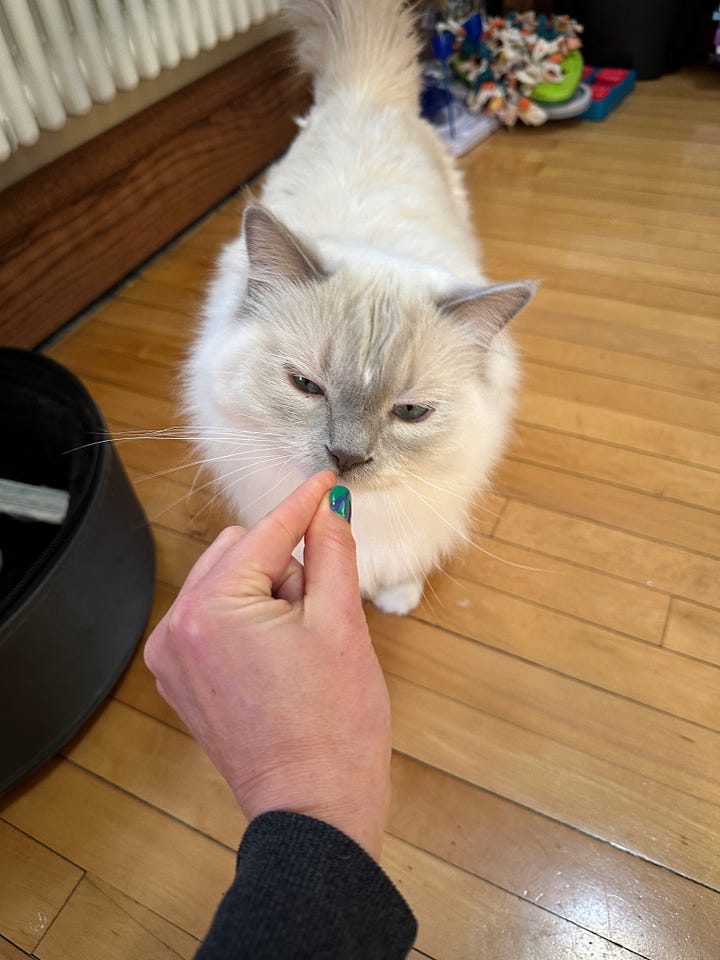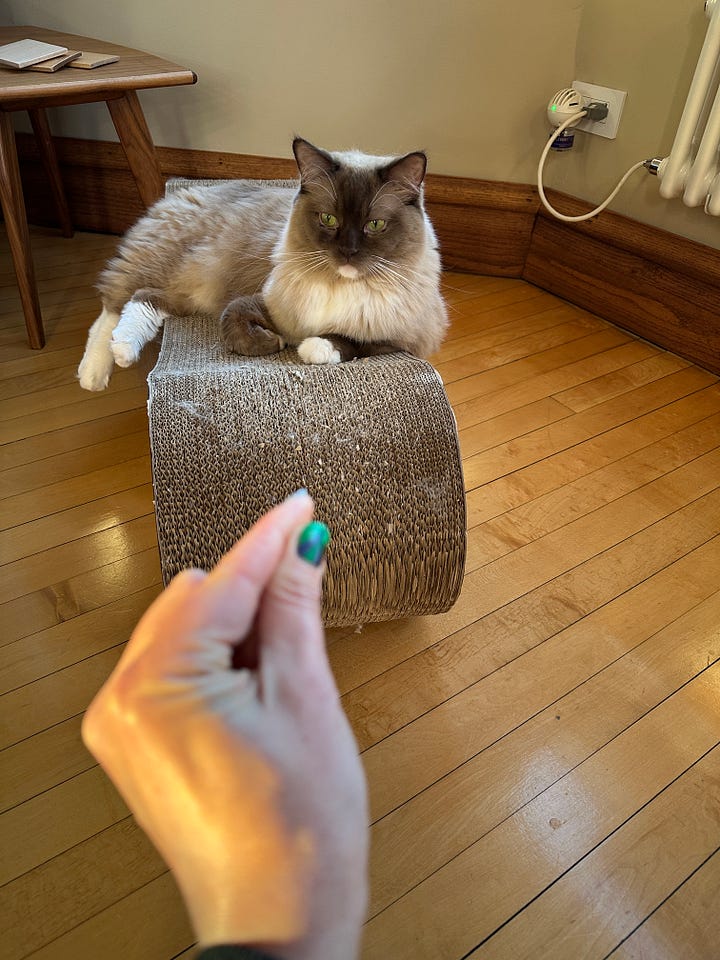All animals need choice and control
Why animal welfare experts are talking about agency and why your dog and cat needs more of it
This is the first in a multi-part series on the topic of animal agency. Also, next week, Valerie Bogie and I will be hosting a live discussion on Zoom on agency in humans and non-human animals. I hope you’ll join us!
Over the past several years, animal welfare experts, behaviorists and trainers have been thinking and talking a lot about agency and how it affects the welfare of captive animals. While the term “captive animals” might conjure images of animals kept in zoos or in intensive farming systems, our dogs and cats are captive animals too (for the most part), and agency is essential for their welfare.
So what is agency?
Agency has many definitions in human social science, including “the ability to influence one’s own actions and the environment.”
Agency’s definition in the animal welfare literature is fairly similar, and applies to humans as well:
Agency is an animal’s ability to make choices and exert control over their environment in a way that aligns with their needs and preferences
Animals express agency when they engage in voluntary and goal-directed behaviors that they are motivated to perform, which has both direct and indirect benefits.
Direct benefits—expressing agency can result in positive experiences and emotions such as joy and satisfaction.
Indirect benefits—expressing agency allows animals to choose resources (ex. food and resting areas) or activities that they enjoy.
Boredom, the converse of agency
Boredom gets a bad rap, but in-and-of itself isn’t all bad—it’s actually adaptive. When animals are bored, they’re prompted to explore their environment in search of resources and interactions that are important to them. Boredom also prompts learning. I’m personally grateful I grew up in the time before smart phones, YouTube, and the bottomless choice rabbit hole of Netflix. While I complained a lot about being bored as a kid, boredom prompted me to get lost in my imagination, read A LOT of books, and learn how to draw—all activities that continue to bring me joy.
Despite the benefits of boredom, you’ve probably worried that your dog or cat is bored. You’re right to be worried too, because excessive boredom can cause chronic stress and increase the risk of stress-related illnesses and behaviors.
Boredom results when there’s a discrepancy between an individual’s motivation for stimulation and the level of stimulation available.1 A dull, unchanging environment with few opportunities to engage in species-specific behaviors and limited choice is a recipe for disaster. When excessively bored, animals will seek out any kind of stimulation, even if it’s aversive, just to get some stimulation.2 Not good.

We can keep excessive boredom at bay and help our animals thrive by giving them an enriched environment with plenty of opportunities to engage in behaviors that are meaningful to them, and by increasing their agency through choice and control.
The benefits of choice and control
Choice is having the opportunity to select from more than one alternative. While having unlimited choice isn’t necessarily great (picture mindlessly scrolling Netflix), research in many species suggests animals prefer having more than one option. Not only does offering animals choice improve their motivation and performance, the opportunity to make a choice is a primary reinforcer—it lights up the reward circuitry in our brains. That means animals will make choices for the sake of making choices. This intrinsic value of choice has been demonstrated across a wide range of taxa—for example, when monkeys, mice, and rats have been given a switch to choose lighting conditions in their enclosures, they press the switch regardless of the initial lighting condition.3 This suggests merely being able to control the condition of their environment is what actually matters to them.
We all appreciate some degree of control, and that appreciation isn’t unique to humans. Animals exert control4 over their environment through choice—in the wild that’s choosing where to find food, what shelter suits them best, who to interact with, and so on. Not only is control critical for healthy development in all animals, a diminished sense of control reduces wellbeing and can lead to maladaptive or harmful behaviors. Has your dog or cat ever struggled, snapped, scratched and bitten while being restrained for a veterinary procedure? Their diminished sense of control in what they perceive to be a life-threatening situation plays a significant role in prompting that intense reaction. This isn’t exclusive to the vet clinic setting either—limiting choice and control contributes to a lot of the aggression we see in many other contexts.
How to offer your pet more choice and control
Thankfully, there are a lot of both safe and practical options for doing this.5 A life in captivity isn’t inherently worse for our pets compared to a “natural” life roaming freely in the wild—what actually matters most is that we meet their needs and provide them with choices that are important to them.6 By providing your pet with choices, you get to learn what’s important to them, as well as how their preferences change over time. Jenny Efimova wrote about how she gives her dog Larkin choice on their walks, and it’s an absolutely beautiful example.
Here are a few potential ways you could introduce a little more choice into your pet’s life:
Taking your dog out for a leashed walk? Let them choose which path or direction you head.
Time to play? Offer a few different toys and let your pet choose which to play with.
Thinking of switching type of litter for your cat? Purchase a few different options and offer them side-by-side. Your cat will tell you which she prefers.
Avoid assuming you know what your pet likes—ask them by offering choices, and keep asking.

Giving animals choice in social interactions is extremely valuable as well—it’s good for their welfare AND will strengthen their relationship with you.
At my practice, we see a lot of dogs and cats that bite their caregivers, often the result of a lot of well-meaning but unwelcome petting, hugging, and cuddling.7 Dogs and cats usually ask for an end to petting subtly at first, so when those signals aren’t recognized or honored, they can escalate to more intense behavior (e.g. growling, snapping, biting) to end what they perceive as an uncomfortable or unpleasant interaction.
We can prevent those relationship-eroding miscommunications by learning to read their body language and asking our pets if they want to interact before diving into cuddle time. In other words, offer them a choice. This is a powerful way to increase their agency, and it’s simple to do. When you want to interact with your pet, rather than approaching them, invite them over to you. For a dog, that could be patting your leg or showing your open hands. For a cat, try getting low to the floor and extended a hand while rubbing your finger and thumb together. Then WAIT.


If they remain where they are, respect their choice—they’re saying “not right now”. If they do approach, pay attention to the spots that cause them to lean into your hand as well as the spots that cause them to lean away. This is a great way to learn their preferences. Also be sure to pause plenty of times between pets to make sure they’re still enjoying the petting—they’ll lean into you or nudge you to request “more please.”
What are ways you think you can start increasing your pet’s agency? How will you go about it?
Thanks so much for reading!
💜, Kelly
Insightful Animals is operated by me, Kelly C. Ballantyne, DVM, DACVB. I’m a vet behaviorist, nature fanatic, bird artist, wife, and mom to two hilarious Ragdoll cats, Pipit and Towhee. In my day-to-day, I consult directly with pet parents and veterinarians on a range of behavior problems in dogs and cats.
Keep in mind the amount of desired stimulation varies among individuals and is influenced by many factors including health and life stage.
Špinka, M., 2019. Animal agency, animal awareness and animal welfare. Anim. Welf. 28, 11–20. https://doi.org/10.7120/09627286.28.1.011
i.e. if dark they make it light, if light they make it dark
Since control is a somewhat loaded word, in this context it’s defined as the ability to predictably and effectively produce desired results in a given situation.
I am not suggesting you release your pet from captivity and allow them to roam freely for hours on end. In most parts of this world, that’s not safe for them, the public, or native wildlife.
Browning, H., Veit, W., 2025. Animal Welfare, Agency, and Animal-Computer Interaction. Anim. : open access J. MDPI 15, 219. https://doi.org/10.3390/ani15020219




